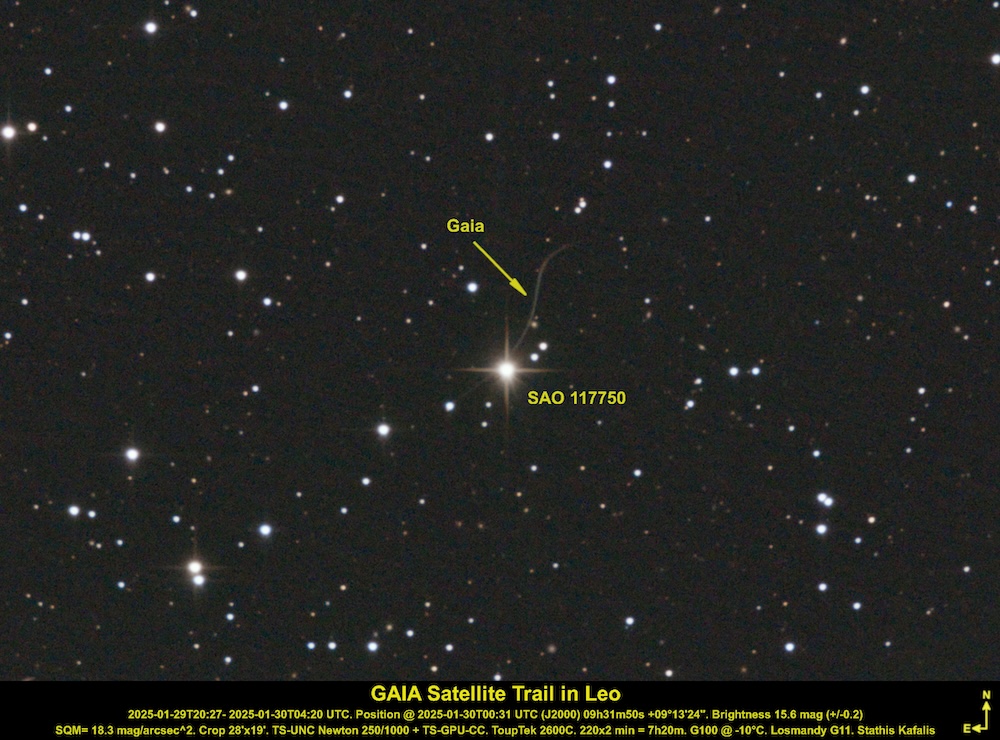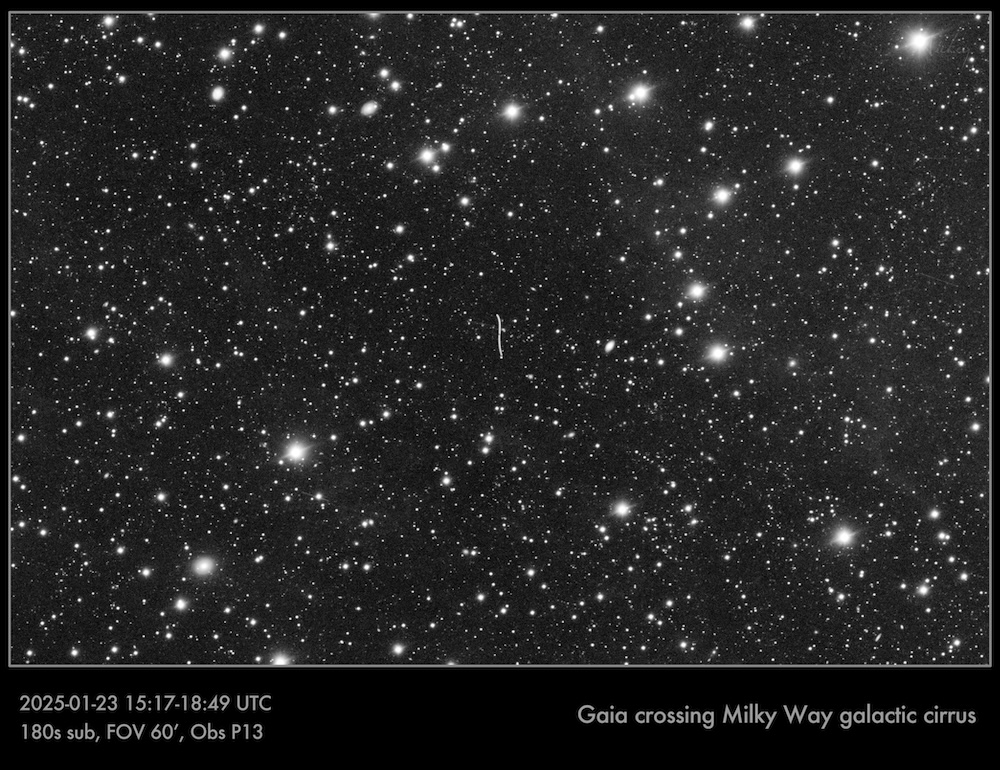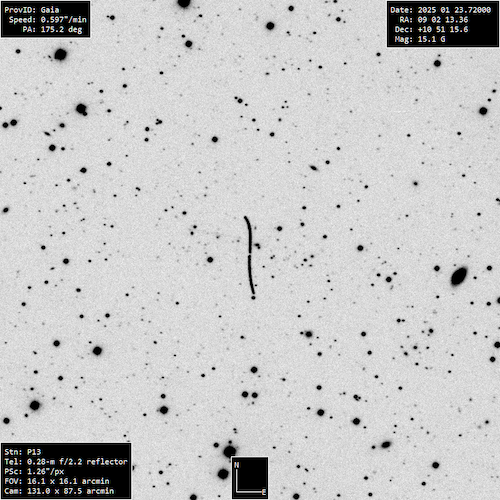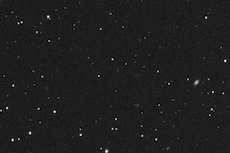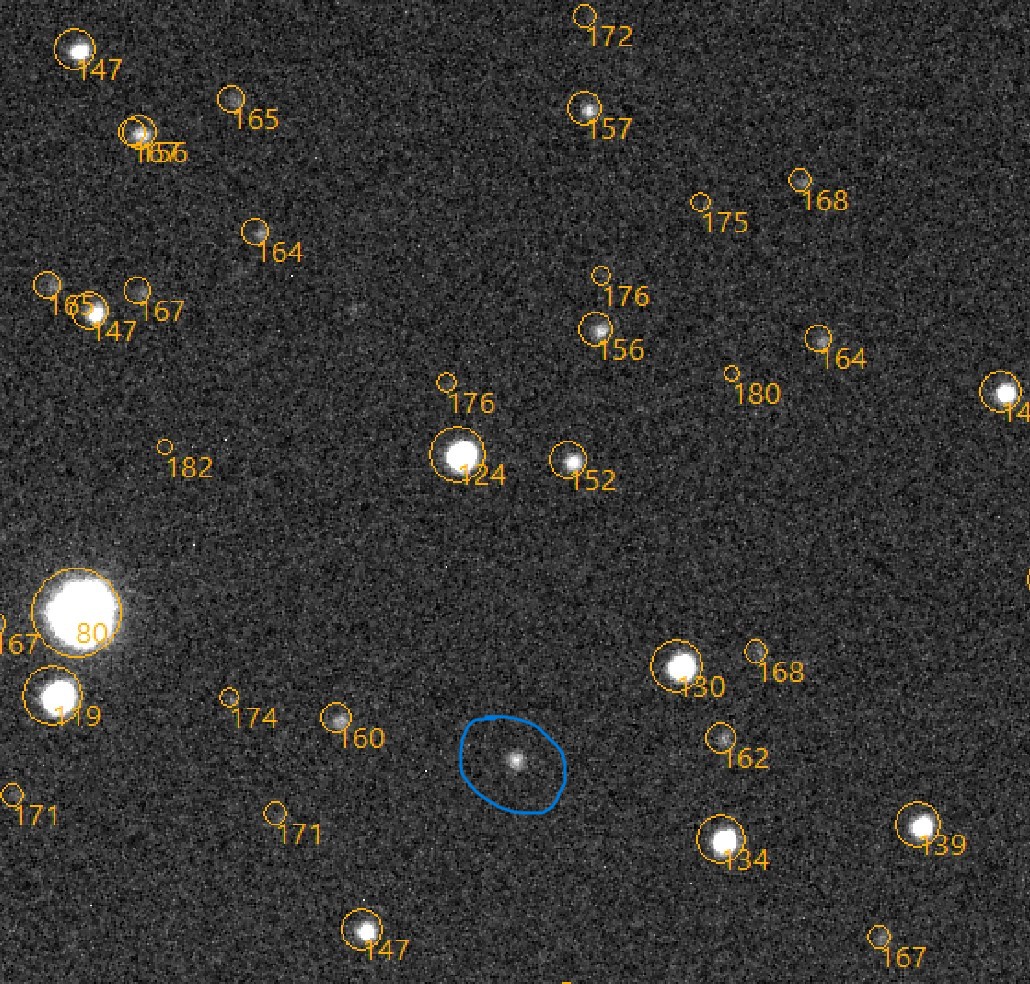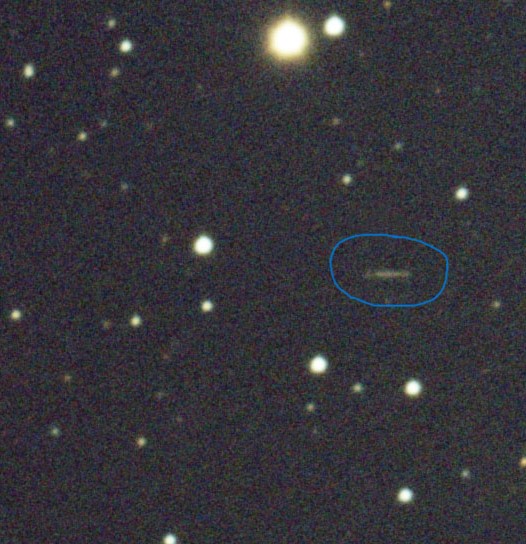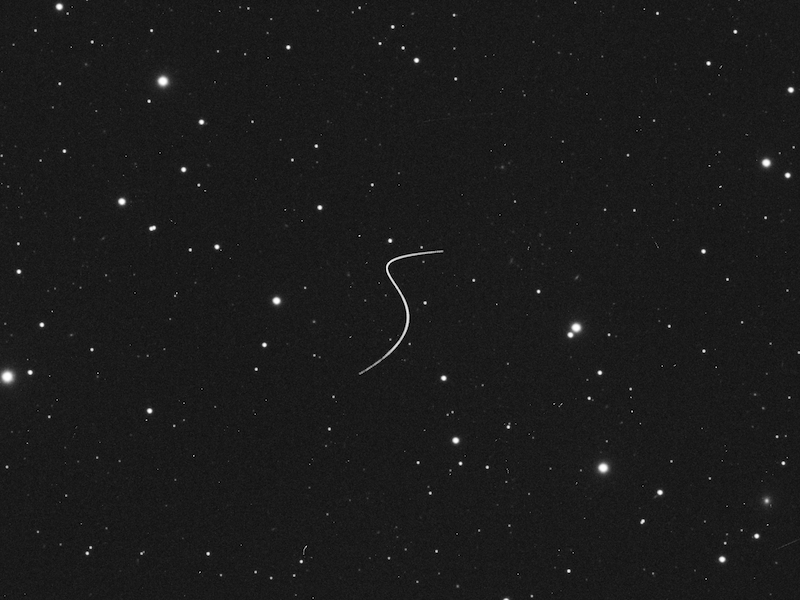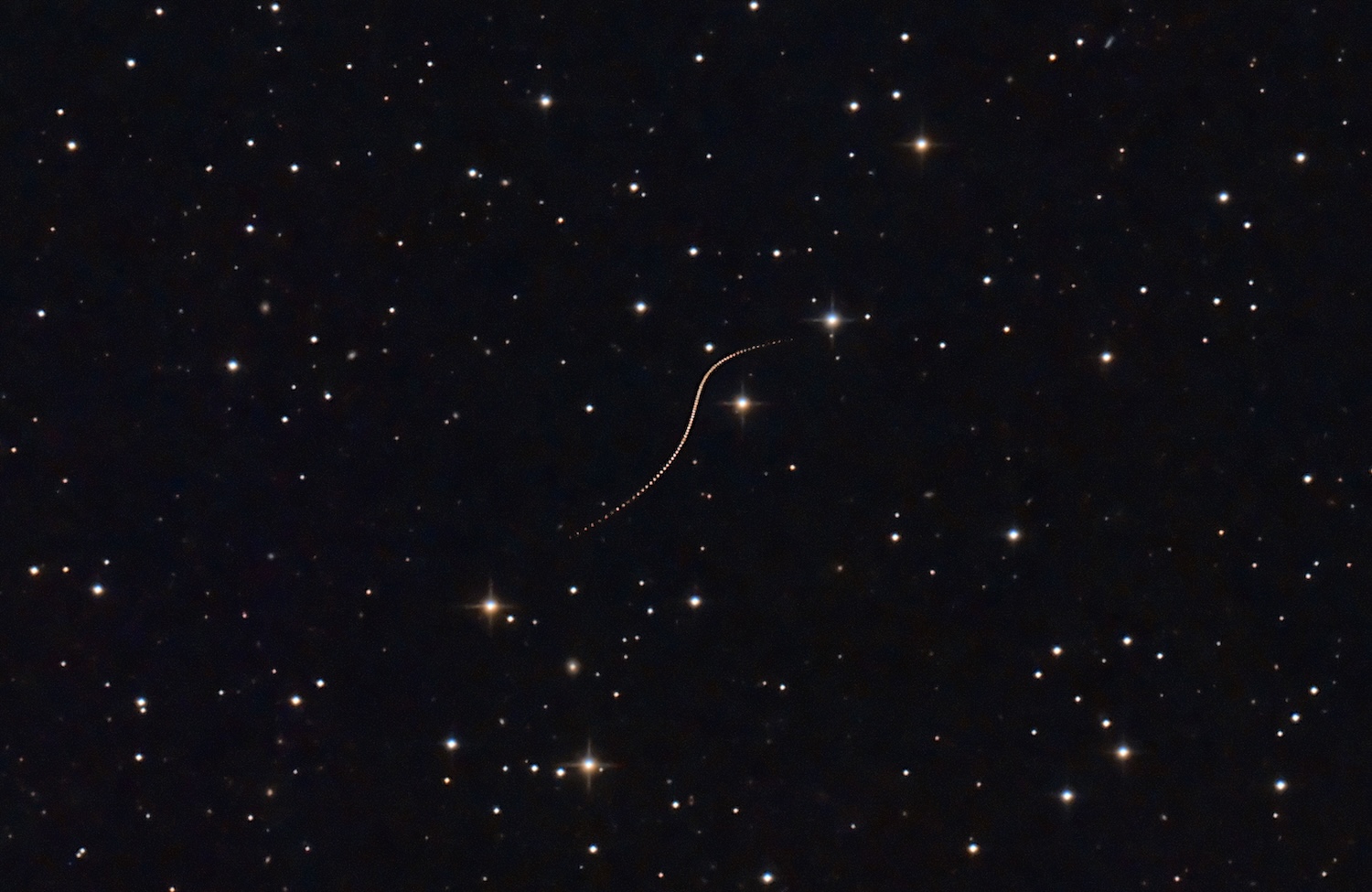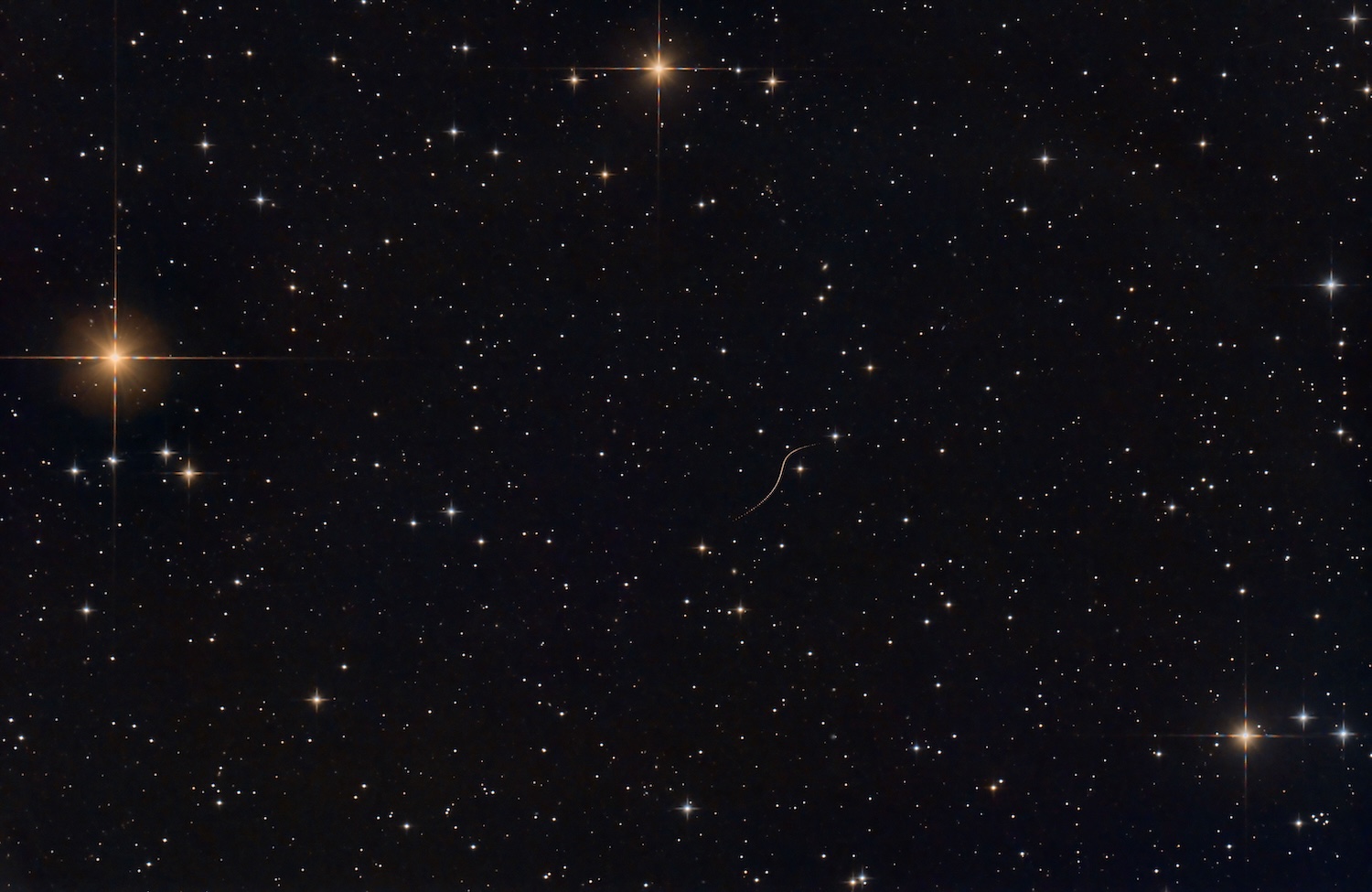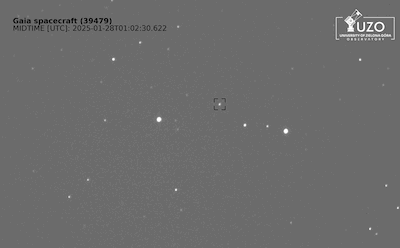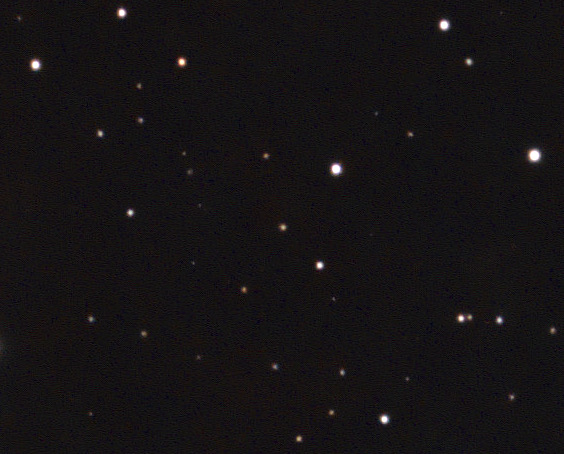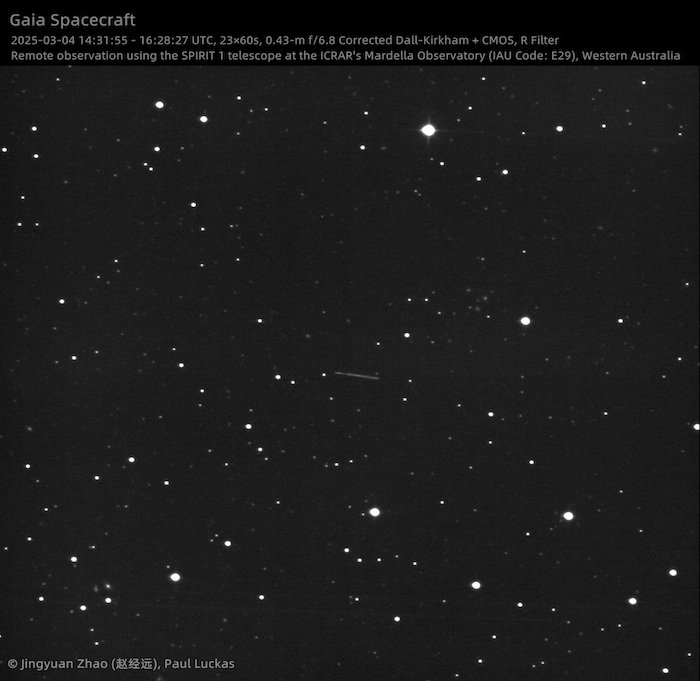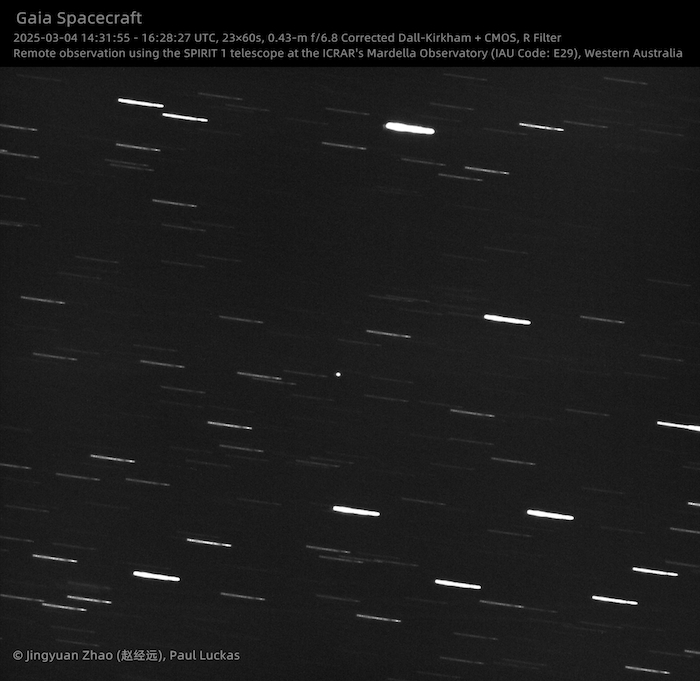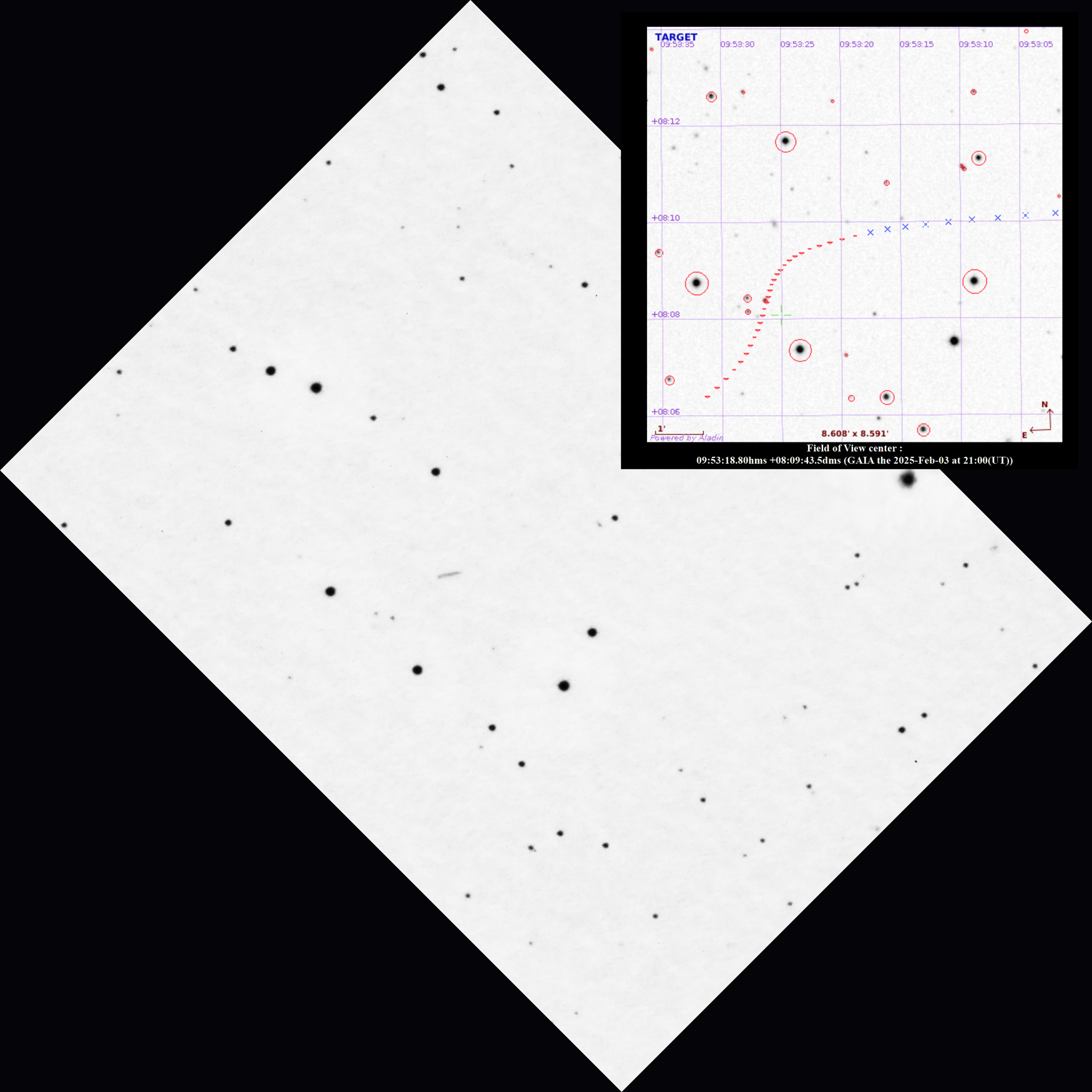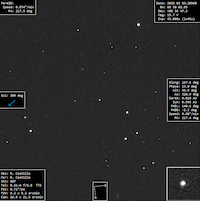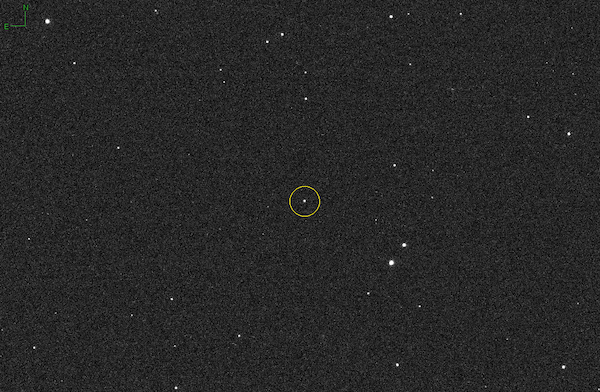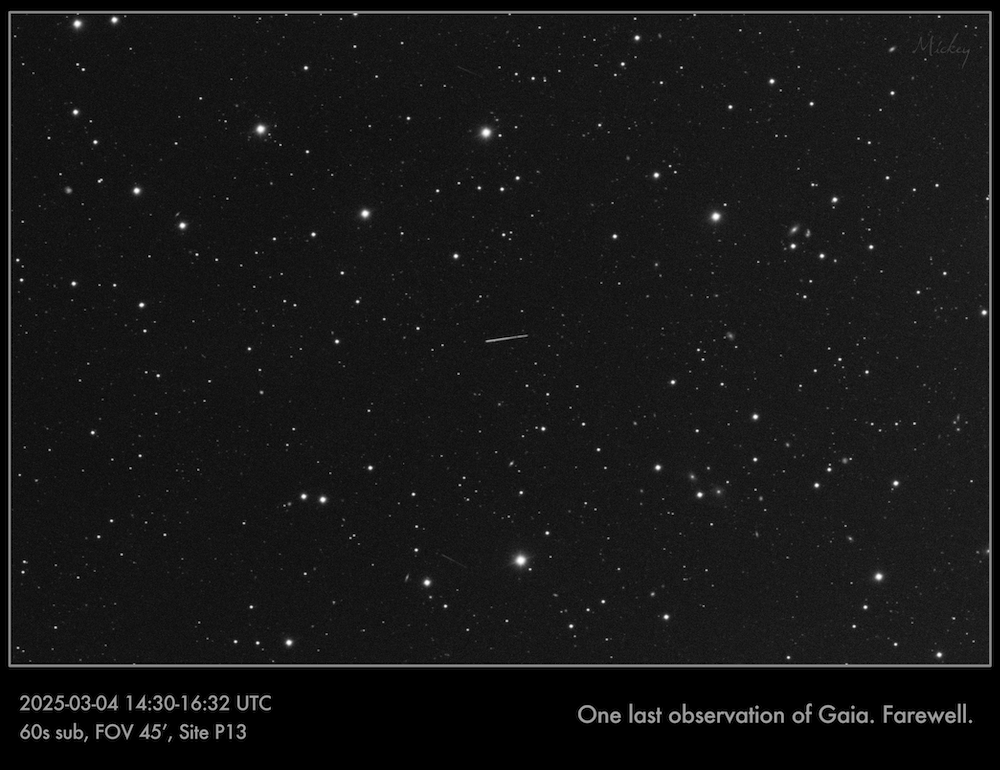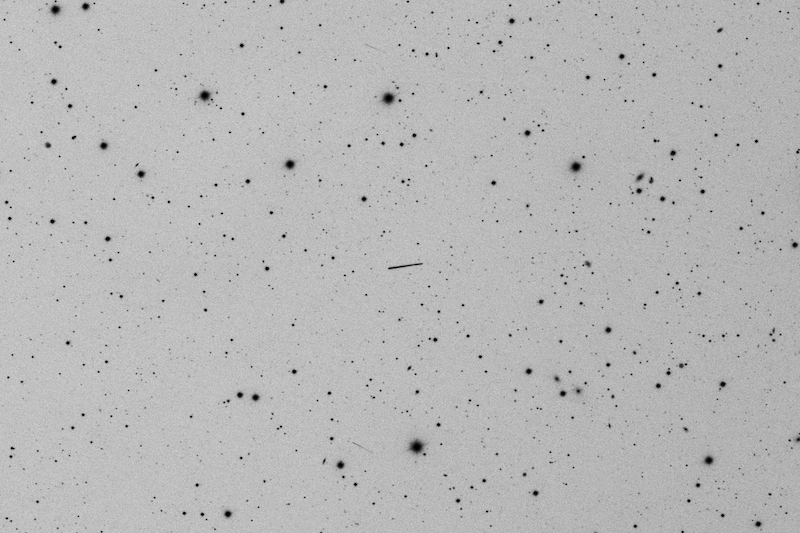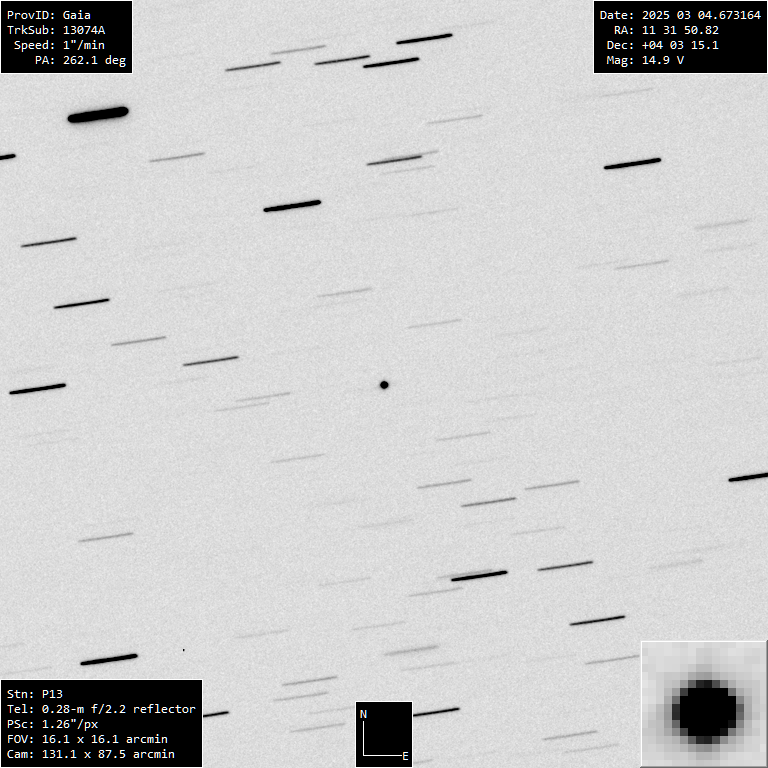Gaia spacecraft observations 2025 - Gaia
Ground-based observations of the Gaia spacecraft in 2025
Between 15 January and 27 March 2025, a period of technology testing takes place. On 15 January, Gaia stopped its scanning of the sky and no new star data was obtained since then. The technology tests performed since then are aimed at increasing our knowledge of the spacecraft and may potentially improve Gaia calibrations and can help the preparation of future missions. The Gaia spacecraft became more easily visible in the night sky and citizen astronomers are invited to follow-up and make observations from the Gaia spacecraft (More information: Gaia observation page). Here we share these observations taken from Earth of the Gaia space telescope.
Quick links
Find below quick links to the different observations from across the world:
22 January 2025 - China - Zhuoxiao Wang
24 January to 31 January - Spain - Jorge Núñez
25 January 2025 - Germany - Andy Bender
25 January 2025 - UK - Mark and Mary McIntyre
26 January 2025 - Poland - Sebastian Kurowski
28 January 2025 - Spain - Liz Phillips
28 January 2025 - Chile - Michal Zejmo
29 January 2025 - Germany - Stathis Kafalis
29 January 2025 - Australia - Jingyuan Zhao (赵经远) and Paul Luckas
31 January to 4 February - Germany - Klaus Wenzel
31 January 2025 - Spain - Pere Gil
01 February 2025 - Portugal - Ed Serpell
01 February 2025 - USA- Bill Keel
03 February 2025 - Chile - Rafael Castillo
03 February 2025 - Belgium - Wesley Verbraecken
04 February 2025 - UK - Juergen Schmoll
04 February 2025 - France - Jean Pierre Rivet
04 February 2025 - UK - Grant Privett
04 February 2025 - UK - Tim Ellison
05 February - 06 February - Spain - Alexander Wrede
08 February - Spain - Tapio Lahtinen (external link to observation service)
19 February 2025 - Germany - Klaus Wenzel
4 March 2025 - Australia - Jingyuan Zhao (赵经远) and Paul Luckas
4 March 2025 - China - Zhuoxiao Wang
We are happy to see so much enthusiasm among citizen astronomers and received many observations from all over the world.
Observations from Germany
Observation performed from Munich, Germany by Stathis Kafalis over 7.3 hours on the night of 29 January 2025 between 20:27 and 04:20 UTC on 30 January. Telescope used is TS-UNC Newton 250/1000 + TS-GPU-Coma Corrector, combined with a ToupTek 2600C camera (IMX 571 Color Sensor)
Observations of the Gaia spacecraft by Stathis Kafalis. Credits: Stathis Kafalis.
Observations from Portugal
Observation performed from Quinta do Lago, Portugal by Ed Serpell using a Seestar S50 (50mm aperture lens mounted on an alt-azimuth mount). The observation was created using stacked 10 second images obtained for a total of 1 to 2 hours on 1 February 2025.
Observations of the Gaia spacecraft by Ed Serpell. Credits: Ed Serpell - CC BY-SA 3.0 IGO.
Observations from Germany
Observations performed on 31 January, 01 February and 02 February from Großostheim Wenigumstadt, Germany by Klaus Wenzel.
Observations of the Gaia spacecraft by Klaus Wenzel on 31 January using 208/812mm Newton telescope, Germany. Observation taken on the 1st of February available here. Credits: Klaus Wenzel - CC BY-SA 3.0 IGO.
Observations of the Gaia spacecraft by Klaus Wenzel on 2 February using 208/812mm Newton telescope, Germany. Another observation was performed on 4 February. Credits: Klaus Wenzel - CC BY-SA 3.0 IGO.
Observations of the Gaia spacecraft by Klaus Wenzel on 17 February using 208/812mm Newton telescope from Germany. At that moment, Gaia was faint at approximately 17th magnitude. He also observed on 19 February but then the Gaia spacecraft was no longer visible and must have been fainter than 18th magnitude. Credits: Klaus Wenzel - CC BY-SA 3.0 IGO.
Observations from Germany
Observations performed on 25 January 2025 between 19:00 and 21:00 UTC from observation location 86405 in Germany by Andy Bender.
Observations of the Gaia spacecraft by Andy Bender, Sternwarte Meckesheim, Germany. G-channel at 15.6 magnitude. Also performed in R-channel at 15.4 magnitude and in B-channel at 16.1 magnitude. Credits: Andy Bender - CC BY-SA 3.0 IGO.
Observations of the Gaia spacecraft by Andy Bender, Sternwarte Meckesheim, Germany. Stacked images showing the movement of Gaia over this period of time. Credits: Andy Bender - CC BY-SA 3.0 IGO.
Observations from Spain
Observations performed from 5 February 2025 20:42 to 6 February 05:55 UTC, 180 exposures of 3 minutes from geographic latitude 42.22 degrees North (Spain) by Alexander Wrede from Germany. Telescope used is the Takahashi TOA130 with 10Micron GM3000 and Camera: Player One Zeus IMX455 Mono Pro using the filter Astronomik Luminanzfilter L2.
Observations of the Gaia spacecraft by Alexander Wrede. Credits: Alexander Wrede - CC BY-SA 3.0 IGO.
Observations from Poland
These observations of the Gaia spacecraft were taken on 26th January 2025, from 21:39 to 22:16 UT, at the astronomical observatory located at the primary school in Sulkowice-Bolecina, in southern Poland by Sebastian Kurowski. Coordinates of the observatory: latitude: 49°49'11.377" N / longitude: 19°22'13.875" E. The observations were performed with a GSO 16-inch Ritchey-Chretien on EQ-8 mount telescope, combined with a ZWO ASI2600MM Pro camera. The exposure time is 180 seconds for each frame, using the R filter.
Observations of the Gaia spacecraft by Sebastian Kurowski. Credits: Sebastian Kurowski – School Astronomical Observatory Bolecina (SOA Bolecina), Poland - CC BY-SA 3.0 IGO.
Observations from the United Kingdom
This video shows the Gaia spacecraft as observed from West Cornforth, County Durham in the United Kingdom by Juergen Schmoll, between 04 February 22:35 UTC to 05 February 01:58 UTC. The video was created from 100 frames of 120 second exposure time each, using a 355/2200mm Schmidt Cassegrain telescope (14" Meade SCT with Starizona f/6.3 reducer). The camera used is a IMX571c chip based Altair Hypercam 26c. The exposures were guided but the tracking was impacted by strong wind. The sky background variation is caused by the moon as it was setting during the 200 minute-observation.
Observations of the Gaia spacecraft by Juergen Schmoll. Credits: Juergen Schmoll.
Observations from United Kingdom
Observation performed from Frimley, Surrey, UK by Tim Ellison for 9 hours on the night of 04 to 05 February 2025, between 20:30 to 05:30 UTC. 250 frames were taken at intervals of a little over two minutes. Equipment used was the Sky-Watcher 200mm aperture f5 Newtonian Telescope with Baader MPCC Coma Corrector, with Altair 26C Cooled Camera and Sky-Watcher AZ-EQ6 Mount, autoguided.
Observations of the Gaia spacecraft by Tim Ellison. Credits: Tim Ellison.
Observations from the United Kingdom
Observation performed near Salisbury, UK by Grant Privett on the night of 4th of February 2025 between 21:43 and 22:18 UTC. Telescope used is a 0.3m f/4 Newtonian reflector with a Starlight Xpress 694 CCD. The observations were stacked and consist of 13x 60 second exposures. At that moment, Gaia's brightness was approximately 15.2.
Observations of the Gaia spacecraft by Grant Privett. Credits: Grant Privett.
Observations from Chile
Observations performed on 28 January between 01:02 to 04:36 from Chile (latitude -30.5 / longitude -70.8 / altitude 1710m) by Michal Zejmo from the University of Zielona Gora Observatory, Poland. Observations were made with a PlaneWave CDK500 telescope system and a QHY268Pro camera, using the g-sloan filter with and exposure time of 60 seconds.
Observations of the Gaia spacecraft by Michal Zejmo. Credits: Michal Zejmo - University of Zielona Gora Observatory, Poland - CC BY-SA 3.0 IGO.
Observations from USA
Observations performed on 1 February 2025 between 04:03 to 04:13 from Tuscaloosa, Alabama, United States of America by Bill Keel.
Observations of the Gaia spacecraft by Bill Keel. Credits: Bill Keel - CC BY-SA 3.0 IGO.
Observations from Australia
Observations performed on 4 March 2025 between 14:31 and 16:28 UTC from the Mardella Observatory in Australia (IAU code: E29) by Jingyuan Zhao (赵经远) and Paul Luckas. Telescope used was the SPIRIT 1 (0.43-m f/6.8 Corrected Dall-Kirkham + CMOS) with an exposure time of 23x60s using the R filter.
Observations of the Gaia spacecraft from the Mardella Observatory on 4 March 2025. Credits: Jingyuan Zhao (赵经远) and Paul Luckas - CC BY-SA 3.0 IGO.
Observations from Belgium
These observations were made by Wesley Verbraecken from Laakdal, Belgium with a Vixen VMC260l telescope in combination with an ASI1600mm camera taking images of 45 seconds each, then combined these images into a stack. The observation was performed on 3 February 2025 between 21:36 and 22:15 UTC.
Observations of the Gaia spacecraft by Wesley Verbraecken. Credits: Wesley Verbraecken.
Observations from France
Observation performed from Nice, France by Jean Pierre Rivet on 04 February 2025. Telescope used is C2PU from the Calern plateau in Nice, France
Observations of the Gaia spacecraft by Jean Pierre Rivet. Credits: Jean Pierre Rivet, Laboratoire Lagrange - Observatiore de la Côte d'Azur, France.
Observations from Spain
These observations were made by Liz Phillips, an undergraduate student from the University of California, Santa Barbara, USA on 28 January 2025 at 22:35 UTC. The telescopee used is located at the Teide Observatory near Tenerife, Canary Islands, Spain.
Observations of the Gaia spacecraft by Liz Phillips. Credits: Liz Pillips/Las Cumbres Observatory.
Observations from Australia
Observations performed on 29 January 2025 between 14:43 and 15:59 UT from the Mardella Observatory (code E29) of the International Centre for Radio Astronomy Research (ICRAR) at the University of Western Australia by Jingyuan Zhao (赵经远) and Paul Luckas. Telescope used was a SPIRIT 3 (0.32-m f/8 Corrected Dall-Kirkham (Planewave CDK 12.5) + CCD (FLI Proline 16803)).
Observations of the Gaia spacecraft by Jingyuan Zhao (赵经远) and Paul Luckas. Credits: Jingyuan Zhao (赵经远), Paul Luckas
Observations from Spain
Observations of the Gaia spacecraft made with the Telescope Fabra-ROA Montsec (TFRM) (0.85m, f/0.96) at the Montsec Observatory, Lleida, Spain (1570m). The videos were compiled by Jorge Núñez (TFRM) from several sequences of unfiltered (475 nm cut filter), 15s and 30s images, obtained with a FLI PL16803 camera from 2025-01-24.88409 to 2025-01-25.12534 UTC and from 2025-01-30.92341 to 2025-01-31.09216.
The Telescope Fabra-ROA Montsec (TFRM), located at the Montsec Observatory (OdM), is a Joint Project between the Reial Acadèmia de Ciències I Arts of Barcelona (RACAB) and the Real Instituto y Observatorio de la Armada en San Fernando (ROA).
Observations of the Gaia spacecraft from Montsec Observatory. Credits: Jorge Núñez
Observations from Spain
Observations of the Gaia spacecraft made with the Joan Oró Telescope (TJO) (0.8m, f/9.6) at the Montsec Observatory, Lleida, Spain (1570m). The video was compiled by Pere Gil (OdM, IEEC) from 8 sequences of 5 R-filter 90s images obtained with the MEIA2 imaging camera from 2025-01-31 21:04:30.651 UTC to 2025-02-01 04:11:02.8 UTC.
The Joan Oró Telescope (TJO) of the Montsec Observatory (OdM) is owned by the Catalan Government and operated by the Institute of Space Studies of Catalonia (IEEC).
Observations of the Gaia spacecraft from Montsec Observatory. Credits: Pere Gil
Observations from the United Kingdom
This video shows the Gaia spacecraft as observed from Oxfordshire, United Kingdom (51.88 degrees N, 1.31 degrees W) by Mark and Mary McIntyre. The video is based on 100 stacked images taken with an 8" Ritchie-Chretien telescope (focal length 1600mm) and an Altair Hypercam 294C camera on an EQ6 mount. All of the exposures were 1 minute, performed over a period of 2 hours between 22:50 and 00:50 UT on 25th January 2025, with a short gap during the observations.
Observations of the Gaia spacecraft by Mark and Mary McIntyre. Credits: Mark and Mary McIntyre.
Final goodbye to Gaia from China
Observations of the Gaia spacecraft over two hours before fading away at 16:32 UTC on 4 March 2025. This was the last moment Gaia was at increased brightness and Gaia is seen to disappear while the solar aspect angle is fast increasing at 16:32 UTC. The observations were conducted using an 11 inch telescope in Beijing (MPC site code P13) by Zhuoxiao Wang.
Last observations of the Gaia spacecraft from China on 4 March 2026. Credits: Zhuoxiao Wang - CC BY-SA 3.0 IGO.








































 Sign in
Sign in
 Science & Technology
Science & Technology
